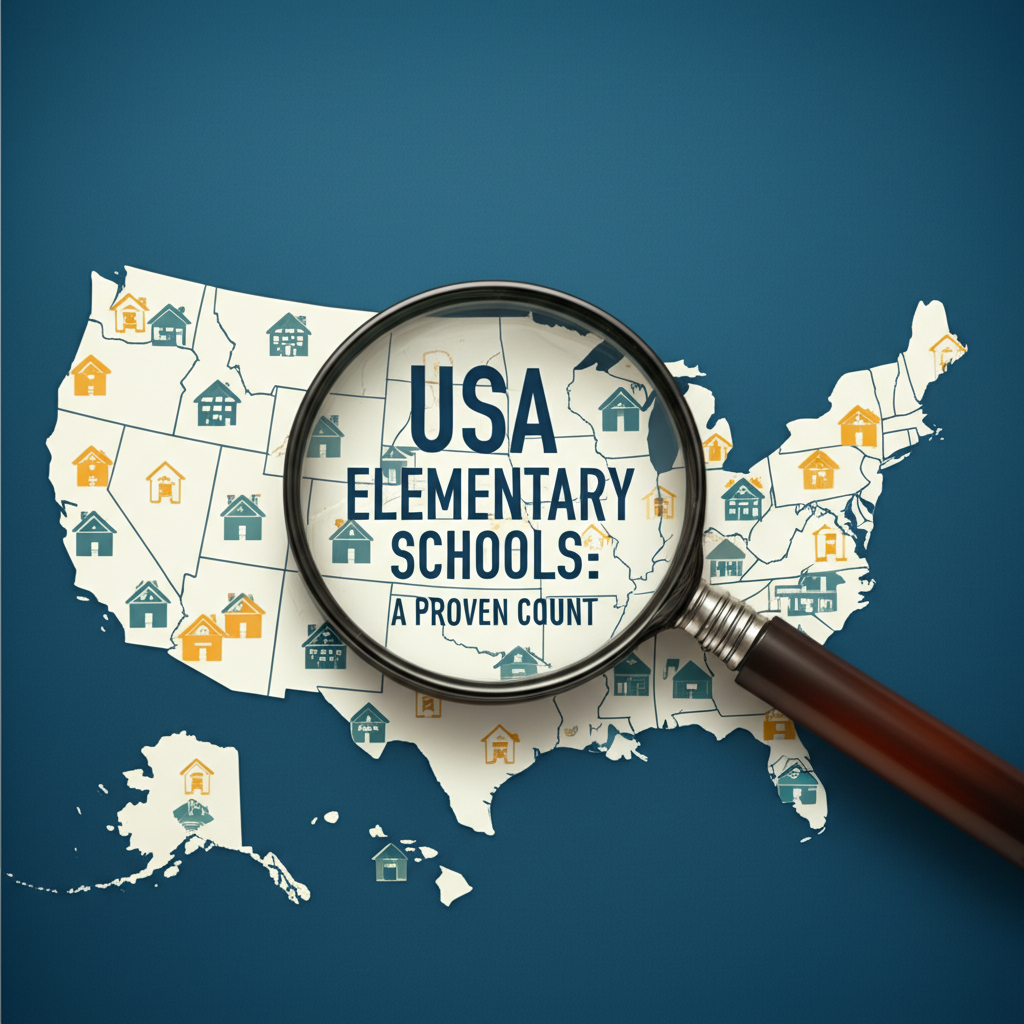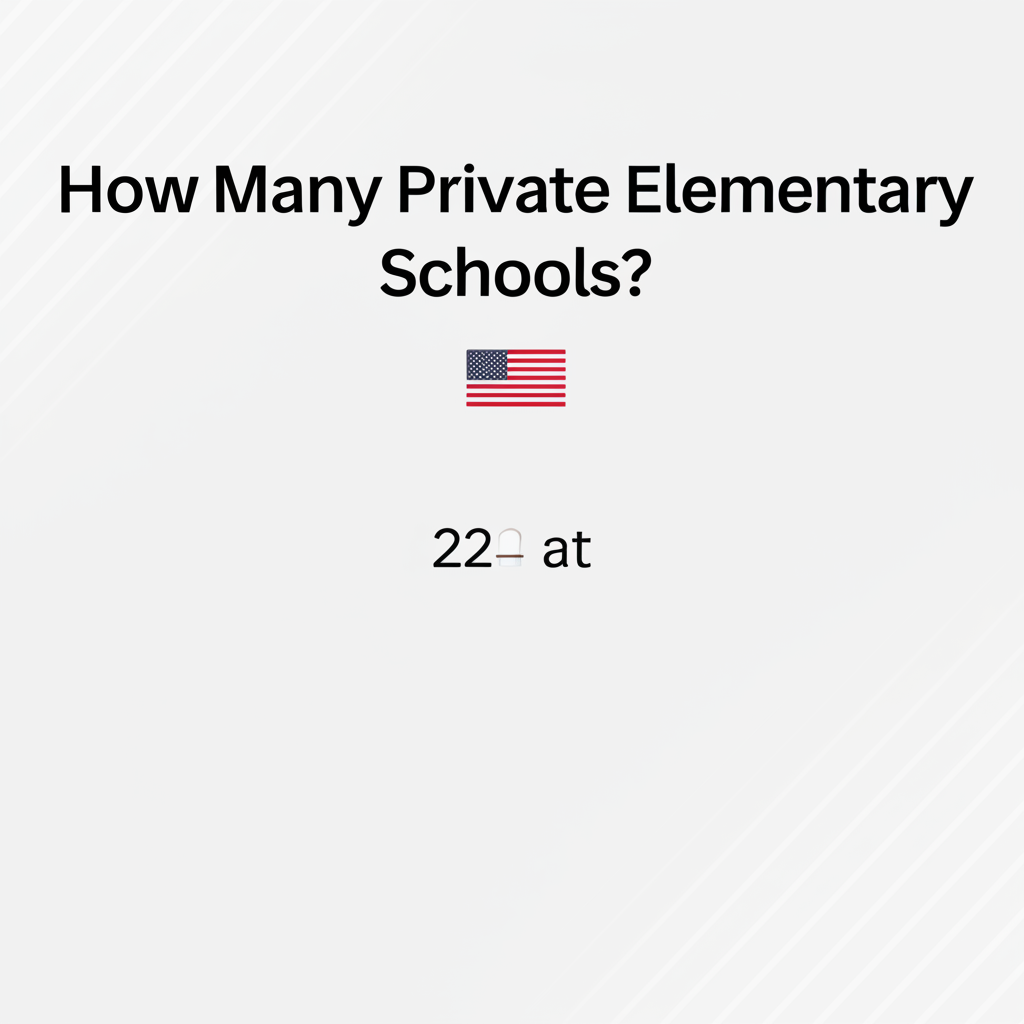Quick Summary: There are approximately 23,000 private elementary schools in the USA. This number fluctuates slightly year to year, with these schools serving a significant portion of the nation’s K-12 student population, offering diverse educational philosophies and religious affiliations.
Understanding the landscape of education in the United States can sometimes feel like navigating a complex map. You might be curious about how many private elementary schools exist, especially if you’re a parent exploring educational options for your child, an educator looking at the broader teaching field, or simply a learner interested in how schools are structured. It’s a common question, and the exact number can seem elusive due to different reporting methods and the dynamic nature of school systems. This guide will demystify the count, break down what defines a private elementary school, and offer clear insights into their presence across the USA. Get ready to gain a solid understanding of this vital part of American education!
What Exactly is a Private Elementary School?
Before we dive into the numbers, it’s important to understand what makes a school “private” and specifically an “elementary” school. This clarity helps us appreciate the data we’ll explore.
Defining “Private School”
Private schools, unlike public schools, are typically funded and operated independently of government control. This independence means they are not bound by the same regulations and mandates that public schools must follow, although they do have certain legal obligations. Key characteristics of private schools include:
- Funding: Primarily funded through tuition fees, endowments, donations, and grants. They do not receive direct public tax dollars for their operations.
- Governance: Usually governed by a private board of trustees or directors, which sets policies, hires staff, and oversees the school’s mission.
- Admissions: Have their own admission criteria, which can include academic performance, interviews, or adherence to a specific philosophy or religious affiliation.
- Curriculum: While many follow state or national standards, they have more flexibility in curriculum design, teaching methods, and the subjects they offer.
Defining “Elementary School”
An elementary school typically serves students from kindergarten through about fifth or sixth grade. The exact grade levels can vary by district and school type. For the purpose of counting, we are focusing on institutions whose primary educational focus is on these foundational years of schooling.
So, a private elementary school is an institution that educates young students, generally from kindergarten to around grade 5 or 6, and is independently funded and operated, not part of the public school system.
The Proven USA Count: How Many Private Elementary Schools Are There?

Pinpointing an exact, static number for private elementary schools across the entire United States is challenging because data collection often involves annual surveys, and the landscape can change. However, reliable sources provide strong estimates based on comprehensive data. The most authoritative source for this kind of information is the National Center for Education Statistics (NCES), part of the U.S. Department of Education.
According to the NCES, in recent years, the number of private elementary schools in the United States has hovered around 23,000. This figure includes a wide range of schools:
- Religious Schools: A significant portion of private elementary schools are affiliated with religious organizations, such as Catholic, Christian, Jewish, and Islamic schools.
- Nonsectarian Schools: These schools do not have a religious affiliation and may focus on specific educational philosophies like Montessori, Waldorf, or college preparatory.
- Special Needs Schools: Some private elementary schools cater to students with specific learning disabilities or special needs.
It’s important to note that these numbers are derived from detailed surveys of schools across the nation. For instance, the NCES conducts the Private School Universe Survey (PSUS), which aims to identify and collect data from all private schools in the United States. This survey is a cornerstone for understanding the private school sector.
To give you a more precise idea, let’s look at some data points:
| Year | Estimated Number of Private Elementary Schools in the USA | Source |
|---|---|---|
| 2020-2021 | Approximately 23,000 | NCES (based on survey data) |
| 2019-2020 | Approximately 23,100 | NCES (based on survey data) |
These figures represent schools that primarily serve students at the elementary level. It’s worth noting that some private schools may offer a range of grades, from preschool through high school, but the count focuses on those with a significant elementary-level enrollment or program.
The Role and Impact of Private Elementary Schools
These nearly 23,000 private elementary schools play a crucial role in the broader educational ecosystem of the United States. They offer alternatives and complements to the public school system, catering to diverse parental preferences and student needs.
Diversity in Educational Philosophies
One of the defining features of private elementary schools is the wide array of educational approaches they employ. This diversity allows parents to choose an environment that best aligns with their values and their child’s learning style. Some common examples include:
- Montessori Schools: Emphasize child-led education, mixed-age classrooms, and hands-on learning.
- Waldorf Schools: Focus on holistic development, integrating arts, movement, and practical skills with academics.
- Reggio Emilia Schools: Known for their project-based learning, student interests, and emphasis on collaboration.
- Classical Schools: Often focus on a traditional curriculum, emphasizing the humanities, languages, and critical thinking through established methods.
- Faith-Based Schools: Integrate religious teachings and values into the curriculum and school culture.
This variety means that “private elementary school” is not a monolithic category; rather, it encompasses a spectrum of educational experiences.
Enrollment and Student Population
While private schools constitute a smaller percentage of the total K-12 student population compared to public schools, their enrollment is significant. According to NCES data, private schools typically enroll around 10% of all students in the United States. This translates to millions of students receiving their primary education in private settings.
For elementary grades specifically, the number of students attending private schools reflects this overall trend. These students often come from families who prioritize specific educational environments, religious instruction, or perceived advantages in academic rigor or class size.
Impact on Educational Innovation
The autonomy of private schools often allows them to be laboratories for educational innovation. Freed from some of the bureaucratic constraints of public systems, they can more readily experiment with new teaching methodologies, curriculum structures, and technological integrations. This can lead to the development of successful models that sometimes influence practices in the public sector.
Furthermore, the competition and choice offered by private schools can encourage public schools to continually evaluate and improve their own offerings to better serve their communities.
Factors Influencing the Number of Private Elementary Schools

The count of private elementary schools isn’t fixed; it can be influenced by several factors. Understanding these helps explain why the number might fluctuate slightly from year to year.
Economic Conditions
The overall health of the economy can impact private school enrollment and the ability of schools to remain operational. During economic downturns, families may find it harder to afford tuition, potentially leading to decreased enrollment and, in some cases, school closures. Conversely, periods of economic prosperity might see an increase in demand for private education.
Demographic Shifts
Changes in population demographics, such as birth rates and migration patterns, can affect the need for elementary school spots, both public and private. Areas with growing young populations might see the establishment of new private schools, while areas with declining numbers might see consolidation or closures.
Parental Demand and Preferences
As mentioned earlier, parental desires for specific educational environments—whether religious, pedagogical, or philosophical—are a primary driver for private school enrollment. Shifts in societal values or increased awareness of different educational models can lead to increased demand for certain types of private schools.
Regulatory Environment
While private schools have more autonomy than public schools, they are still subject to certain state and federal regulations, particularly regarding health, safety, and non-discrimination. Changes in these regulations can sometimes impact the operational viability or establishment of new private institutions.
Technological Advancements
The rise of online learning and hybrid educational models has also influenced the private school sector. While most private elementary schools operate in physical locations, some may incorporate online components, and new online-only private elementary options might emerge, contributing to the evolving landscape of private education.
How to Find a Private Elementary School
If you’re a parent or guardian looking for a private elementary school, knowing where to look is key. Here’s a step-by-step approach:
- Define Your Priorities: What is most important to you? Consider factors like:
- Religious affiliation or secular education
- Educational philosophy (Montessori, Waldorf, traditional, etc.)
- Class size and student-teacher ratio
- Location and commute
- Extracurricular activities and special programs
- Tuition costs and financial aid availability
- Utilize Online Directories and Databases: Several organizations maintain comprehensive lists of private schools. Some excellent resources include:
- National Association of Independent Schools (NAIS): nais.org – A membership association for K-12 independent schools, many of which are private.
- The College Board: While known for college admissions, they also have resources for K-12, and some private schools are listed.
- State-Specific Associations: Many states have their own associations of independent or private schools that offer searchable directories.
- Local Search Engines: A simple Google search for “private elementary schools near me” or “[your city] private elementary schools” will yield many results.
- Consult with Other Parents and Educators: Word-of-mouth referrals can be invaluable. Talk to friends, neighbors, or educators in your community for recommendations and insights.
- Visit Schools: Once you have a shortlist, schedule visits. This is the best way to get a feel for the school’s atmosphere, meet staff, observe classes, and ask questions.
- Review Accreditation and Affiliations: Check if the school is accredited by a recognized accrediting body. This often indicates that the school meets certain standards of quality and operation.
Remember that each private elementary school has its unique strengths and focus, so thorough research tailored to your specific needs is essential.
Comparison: Private vs. Public Elementary Schools
To better understand the role of private elementary schools, it’s helpful to compare them with their public counterparts. While both aim to educate children, they differ significantly in structure, funding, and operation.
| Feature | Public Elementary Schools | Private Elementary Schools |
|---|---|---|
| Funding | Primarily government (federal, state, local taxes) | Tuition, endowments, donations, grants |
| Governance | Governmental bodies (school boards, state departments of education) | Private boards of trustees/directors |
| Admissions | Open to all students within a geographic district; lottery systems in some cases | Selective; based on school’s criteria (academic, religious, etc.) |
| Curriculum | Must adhere to state and federal standards; less flexibility | More flexibility; can implement specialized curricula and teaching methods |
| Teacher Certification | Teachers typically required to hold state certification | Certification requirements vary; often not mandated by the state |
| Regulation | Highly regulated by government agencies | Less regulated; subject to some state/federal oversight (e.g., health, safety) |
| Student Body | Represents the diversity of the local community | Can be more homogenous or specialized based on school’s mission |
| Class Size | Varies, often larger due to public funding models | Often smaller, though this can vary widely |
This table highlights the fundamental differences. Public schools serve as a universal resource, funded by taxpayers and governed by elected or appointed officials to provide education to all children in a district. Private schools, on the other hand, operate with greater autonomy, catering to specific needs or preferences and funded by those who choose to attend.
Frequently Asked Questions (FAQs)
Q1: Are private elementary schools accredited?
Many private elementary schools seek accreditation from recognized accrediting bodies. Accreditation signifies that a school has met rigorous standards for educational quality, faculty, curriculum, and student services. However, accreditation is not always mandatory for private schools, and the specific bodies they are accredited by can vary.
Q2: Do private elementary schools receive government funding?
Generally, private elementary schools do not receive direct operational funding from the government. Their primary sources of income are tuition fees, donations, and endowments. Some private schools might benefit indirectly from government programs, such as voucher programs in certain states that allow public funds to follow a student to a private school, or through tax exemptions.
Q3: What is the average tuition for a private elementary school?
Tuition costs for private elementary schools can vary dramatically based on location, the school’s mission, and the services offered. On average, tuition can range from $5,000 to $20,000 or more per year. Religious schools often have lower tuition rates than nonsectarian independent schools.
Q4: How do I know if a private elementary school is a good fit for my child?
A good fit depends on your child’s individual learning style, personality, and needs, as well as your family’s values and expectations. Visiting the school, speaking with teachers and administrators, observing classrooms, and understanding the school’s mission and philosophy are crucial steps in determining a good fit.
Q5: Can private schools discriminate in their admissions?
Private schools generally have more freedom in their admissions policies than public schools. Many religious private schools may give preference to students of their faith, and some nonsectarian schools may have academic or other criteria. However, all schools must comply with federal laws that prohibit discrimination based on race, color, or national origin.
Q6: What are the benefits of attending a private elementary school?
Potential benefits often cited include smaller class sizes, a strong sense of community, specialized educational programs, religious instruction, and a focus on academic rigor or specific pedagogical approaches. Parents often choose private schools for the perceived higher quality of education or a learning environment that aligns with their family’s values.
Conclusion
In summary, the United States is home to approximately 23,000 private elementary schools. These institutions form a vital and diverse segment of the nation’s educational landscape, offering a wide array of choices for families seeking alternatives to public schooling. From faith-based institutions to schools pioneering innovative pedagogical methods, private elementary schools contribute significantly to educational variety and excellence.
Understanding the numbers, the definitions, and the factors influencing private education empowers parents, educators, and students to make informed decisions. Whether you’re drawn to the specialized curricula, the unique community focus, or the specific values that many private elementary schools uphold, this guide has provided a clear overview of their prevalence and impact. By knowing where to find and how to evaluate these schools, you can better navigate the educational pathways available to children today.

